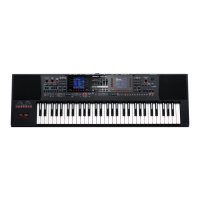5
An Overview of the E-A7
Eects
The E-A7 contains the following eects units. You can make settings independently for each of them.
MFX (Multi Eects)
This is a general-purpose multi-eect that modies the sound itself, potentially giving it a completely dierent tonal character.
A wide variety of types are provided, and you can choose the type that’s most appropriate for your purpose.
There are a total of three MFX units: one unit dedicated to the keyboard part, and two units for backing.
Chorus
Chorus is an eect that adds depth and spaciousness to the sound. You can choose whether to use this eect unit as chorus or as delay.
The depth of chorus can be adjusted individually for each part.
Reverb
Reverb is an eect that gives the sound a spatial ambience that’s characteristic of a performance in a hall.
Several types are provided, and you can choose the type that’s most appropriate for your purpose.
The depth of reverb can be adjusted individually for each part.
Input EFX
This unit can apply reverb or other eects to the sound from the input jacks.
Mastering Tools
The mastering tools consist of a mastering compressor and equalizer that are applied to all parts.
About the Styles
The E-A7 can generate interactive accompaniments based on the style you select.
Styles are assigned to the Style buttons by category, and each Style button is also divided into sub-categories.
In addition to using the internal styles, you can also create your own original styles.
&
“Style Composer” (p. 39)
Style data is a collection of accompaniment patterns (called “divisions”) each consisting of up to eight parts. Based on four accompaniment
variations for dierent energy levels of the main song, they include divisions such as intros, endings, and lls.
By using the panel buttons to switch between these divisions, you can freely create the structure of the song while you perform.
As you perform, the accompaniment changes according to the chords that you play on the keyboard.
Style
Makeup Tools (various settings) (p. 50)
5 Oset values for Volume and Pan etc.
5 EQ
5 MFX A/B
5 Chorus/Reverb
* These settings are made for each tone or drum kit included in the style.
Performance data
Intro 1–4 Variation 1–4 Fill 1–4 Ending 1–4
ACC1
ACC2
ACC3
ACC4
ACC5
ACC6
Bass
Drum
Performance data for each Part, each Division
5 Note
5 Program Change
5 Control Change
etc...
Division
Part
One Touch 1–4 (p. 23)
One Touch memorizes the settings of the Keyboard Part (such
as Upper1).
Use these when you want to recall performance settings that are
appropriate for the style.

